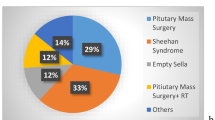Abstract
Circulating atrial natriuretic peptide (ANP) was assayed before and after postural change and exercise in 54 patients with familial dysautonomia (FD) and 20 controls. ANP levels were compared with blood pressure, heart rate, plasma catecholamines and parameters of renal function. Compared with controls supine FD subjects had elevated blood pressures, heart rates and ANP levels (39 ± 4 pg/ml vs. 23 ± 3 pg/ml,p < 0.01). With the erect posture and exercise in FD subjects, blood pressure fell below control values, with ANP lowered. In FD subjects, blood pressure was correlated with ANP levels when supine and when erect and with heart rate post exercise. In controls, ANP levels did not correlate with other parameters. In FD patients on metoclopramide, supine and erect blood pressure and ANP levels were higher. FD subjects treated with fludrocortisone, had elevated supine and erect noradrenaline (p < 0.05 andp = 0.06); and those on diazepam had lower erect and post exercise noradrenaline (p < 0.05), but ANP levels were similar. In conclusion, sympathetic denervation may increase FD patients' responsiveness to other regulators of cardiovascular integrity, such as ANP. In addition, circulating ANP and catecholamines in FD subjects appear to be influenced by commonly used medications, such as metoclopramide.
Similar content being viewed by others
References
Tunny TJ, Gordon RD, Klemm SA, Bachmann AW, Finn WL. Inappropriately elevated levels of atrial natriuretic peptide may contribute to the pathophysiology of orthostatic hypotension.Clin Exp Physiol 1991;19: 283–286.
Ziegler MJ, Lake RC, Kopin IJ. Deficient sympathetic nervous system response in familial dysautonomia.N Engl J Med 1976;294: 630–633.
Pearson J, Axelrod FB, Dancis J. Current concepts of dysautonomia: neurological defects.Ann NY Acad Sci 1974;228: 288–300.
Laragh JH. Atrial natriuretic hormone, the renin-aldosterone axis, and blood pressure—electrolyte homeostasis.N Engl J Med 1985;313: 1330–1340.
Yandle TG, Richards AM, Nicholls MG, Cuneo R, Espiner EA, Livesey JH. Metabolic clearance rate and plasma half life of alpha-human atrial natriuretic peptide in man.Life Sci 1986;38: 1827–1833.
Axelrod FB, Glickstein JS, Weider JL, Gluck MC, Friedman D. The effects of postural change and exercise on renal haemodynamics in familial dysautonomia.Clin Auton Res 1993;3: 195–200.
Friedman DM, Schacht RG, Rutkowski M, Doyle E, Danilowicz D. Renal artery Doppler blood velocity wave forms in children with aortic coarctation.Cardiology in the Young 1992;2: 1884–1890.
Musso NR, Gianrossi R, Pende A, Vergassola C, Lotti G. Plasma dopamine response to sympathetic activation in man: a biphasic pattern.Life Sci 1990;47: 619–626.
Gutkowska J, Bourassa M, Roy D, Thibault G, Garcia R, Cantin M, Genest J. Immunoreactive atrial natriuretic factor (IR-ANF) in human plasma.Biotel Biophys Res Comm 1985;128: 1350–1357.
Burnett JC Jr, Kao PC, Hu DC, Heser DW, Heublein D, Granger JP, Opgenorth TJ, Reeder GS. Atrial natriuretic peptide elevation in congestive heart failure.Science 1985;231: 1145–1147.
Needleman P, Greenwald JE. Atriopeptin: a cardiac hormone intimately involved in fluid, electrolyte and blood pressure homeostasis.N Engl J Med 1986;314: 828–834.
Kuchel O, Debinski W, Racz K, Buu NT, Garcia R, Cusson JR, Larochelle P, Cantin M, Genest J. An emerging relationship between peripheral sympathetic nervous activity and atrial natriuretic factor.Life Sci 1987;40: 1545–1551.
Pearson J, Pytel B. Quantitative studies of sympathetic ganglia and spinal cord intermediolateral gray columns in familial dysautonomia.J Neurol Sci 1978;39: 47–59.
Grover-Johnson N, Pearson J. Deficient vascular innovation in familial dysautonomia, an explanation for vasomotor instability.Neuropath Appl Neurobiol 1976;2: 217–224.
Goodall G, Gitlow SE, Alton H. Decreased noradrenaline synthesis in FD.J Clin Invest 1971;50: 2734–2740.
Landau H, Friedman J, Rosler A, Moses SW, Freier S, Rotem Y, Rabinowitz D. Salt conservation in familial dysautonomia (Roley—Day syndrome).Israel J Med Sci 1977;13: 278–282.
Richards AM, Crozier IG. Elevated atrial natriuretic factor in the plasma: cause or effect in ‘idiopathic orthostatic hypotension’.Int J Cardial 1990;29: 252–254.
McKnight JA, Roberts G, Sheridan B, Atkinson B. Relationship between basal and sodium-stimulated plasma atrial natriuretic factor, age, sex and blood pressure in normal man.J Human Hypertens 1989;3: 157–163.
Author information
Authors and Affiliations
Rights and permissions
About this article
Cite this article
Axelrod, F.B., Krey, L., Glickstein, J.S. et al. Atrial natriuretic peptide response to postural change and medication in familial dysautonomia. Clinical Autonomic Research 4, 311–318 (1994). https://doi.org/10.1007/BF01821531
Received:
Revised:
Accepted:
Issue Date:
DOI: https://doi.org/10.1007/BF01821531




